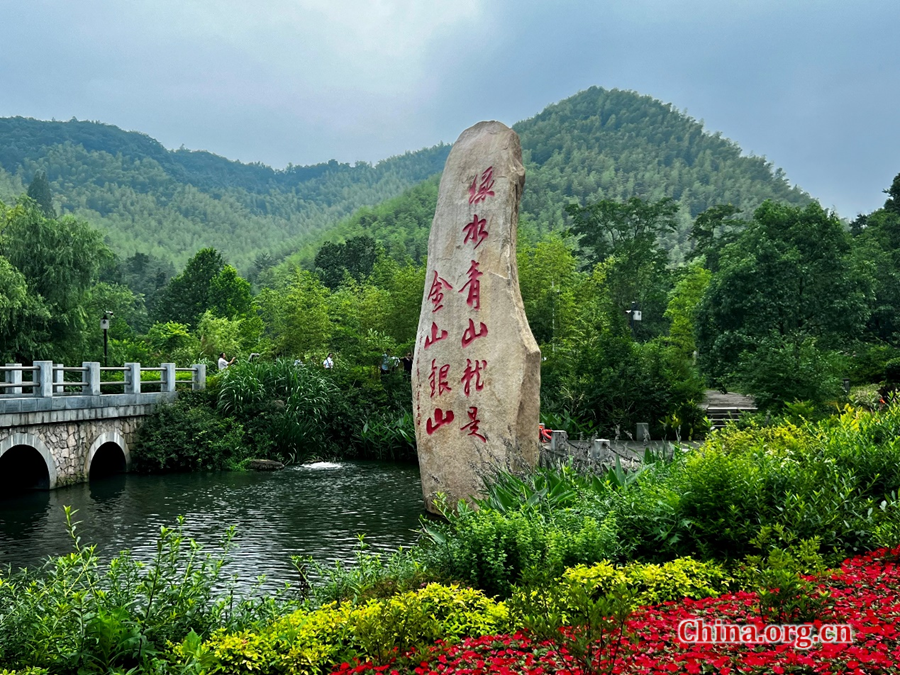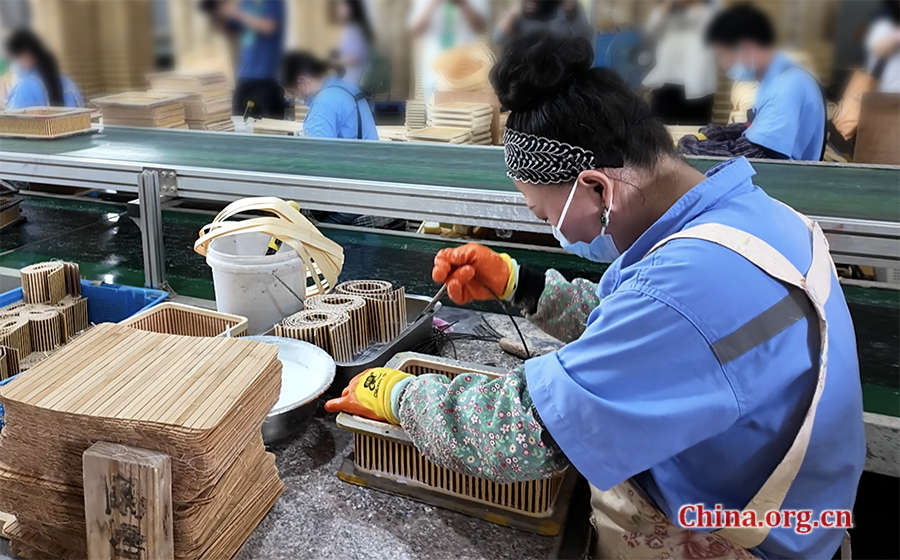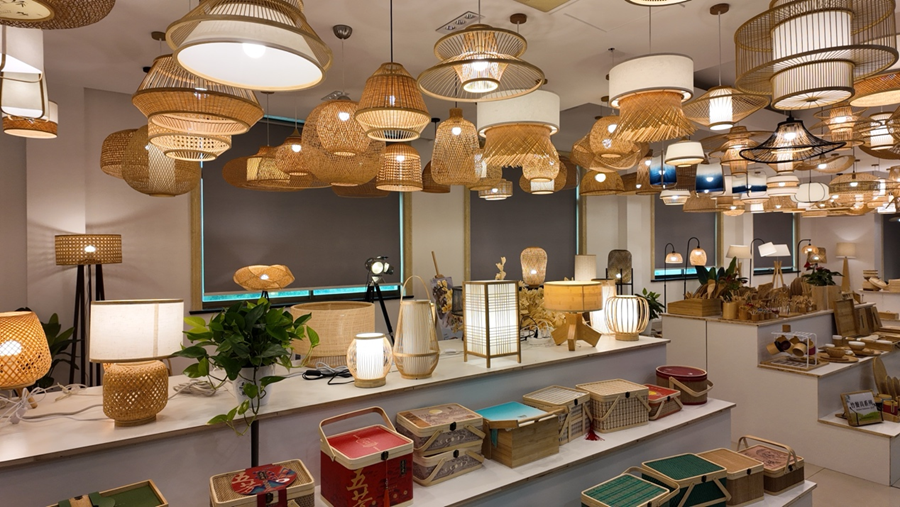
Photo taken on June 12, 2025 shows the view of Yucun village of Anji county, eastern China's Zhejiang province. Anji county has made great efforts to promote green development in rural areas. [Photo by Cui Can/China.org.cn]
In the lush hills of Anji county, eastern China's Zhejiang province, summer comes with the dense, whispering green of bamboo forests. Here, a single stalk of bamboo, humble and fast-growing, can find its way into upscale European restaurants as sleek dinnerware, or appear as a minimalist bamboo lamp on the shelves of MUJI and IKEA stores worldwide.
With about 720 square kilometers of bamboo groves, Anji has embraced bamboo as both a cultural symbol and an economic resource. Today, it is emerging as a pioneer in developing the bamboo industry to drive green development.
"Bamboo is not only tough and durable, but also renewable," said Liu Yu, chief expert of the Zhejiang Provincial Department of Ecology and Environment. "Compared to wood, which can take over a decade to mature, bamboo is harvest-ready in just four to six years and can regrow without replanting."
Liu also noted that responsible harvesting benefits the ecosystem. "If left uncut, bamboo becomes prone to disease and pests. Its aggressive root system can also outcompete other plant life, reducing biodiversity."

A worker processes bamboo at a company in Anji county of Huzhou city, Zhejiang province, June 13, 2025. [Photo by Cui Can/China.org.cn]
To harness bamboo's environmental potential, China in 2022 launched a "Bamboo as a Substitute for Plastic" initiative in collaboration with the International Bamboo and Rattan Organization. A year later, the National Development and Reform Commission and several other government departments introduced a three-year action plan to accelerate the implementation of the initiative. Anji was named one of the program's first demonstration bases.
Currently, more than 1,000 enterprises in Anji are involved in the bamboo industry, over 40 of which are large-scale operations. Around 70% of their products are exported to markets like the United States, Europe, Japan, and South Korea, said Zhou Jihui, who oversees the "Bamboo for Plastic" project at the Anji Development and Reform Bureau.

Photo taken on June 13, 2025 shows the bamboo packaging, lighting, and tableware produced by a company in Anji county of Huzhou city, Zhejiang province. [Photo by Cui Can/China.org.cn]
Zhejiang Fenghui Bamboo and Wooden Products Co. Ltd., founded in 1990, is one of Anji's largest bamboo manufacturers and exporters. When General Manager Liang Fenghui took over the business from his father in 2014, the company focused on low-value raw products like bamboo poles and fences. "The profit margins were slim, and environmental standards were rising. Many companies were shut down, and some bamboo forests were abandoned," he recalled. "We had to transform."
The company began to invest in developing a more diversified product line, ranging from bamboo kitchenware and dining items to garden products. It now offers a portfolio of over 1,000 bamboo products.
And as Anji aligns itself with China's broader green development strategy, local bamboo manufacturers like Fenghui are making sustainability a priority. "Our production process is now cleaner, and we've developed machinery that improves material utilization by at least 20%," Liang said.
Today, Bamboo tableware accounts for 60% of the company's revenue. It exports bamboo packaging, lighting, and tableware to clients across Japan, France, Spain, and the U.S. In 2024, the company's export value reached 150 million yuan (about US$21 million), with Japan and France each accounting for 20% of sales, and the U.S. around 10%.
According to Zhou of the Anji Development and Reform Bureau, the county's bamboo sector has improved incomes for more than 51,000 local farming households. In 2024 alone, bamboo-related income increased each household's earnings by an average of 6,500 yuan. "And 167 village collectives each saw their revenues grow by more than 1 million yuan," she said.

Photo taken on June 13, 2025 shows bamboo tableware at a company in Anji county of Huzhou city, Zhejiang province. [Photo by Cui Can/China.org.cn]
As Anji accelerates its "Bamboo for Plastic" initiative, the county has been exploring more ways to bring bamboo into everyday life. In hospitality, bamboo toothbrushes, combs, and takeaway cutlery are replacing plastics. In local markets, plastic bags have been gradually phased out in favor of biodegradable ones made from bamboo powder. "They decompose within three months and are stronger than plastics," Zhou noted.
And whereas plastic products are generally cheaper than bamboo products of the same kind, Zhou said price isn't always the key concern. "Consumers, especially in hospitality, often care more about the product's look and whether it matches their brand image than about the cost. That gives us more room to innovate."
To meet this rising demand, Liang is investing in design and branding. "We're incorporating traditional Chinese cultural elements into packaging and product design to appeal to younger consumers. And with cross-border e-commerce platforms, we're reaching more global audiences."
In 2024, the total output value of Anji's bamboo industry reached 19.2 billion yuan, up 7% over the previous year, according to Zhou. "That was nearly 2.6 billion yuan more than in 2022. The growth momentum is very strong."


 Share:
Share: 




 京公網(wǎng)安備 11010802027341號(hào)
京公網(wǎng)安備 11010802027341號(hào)